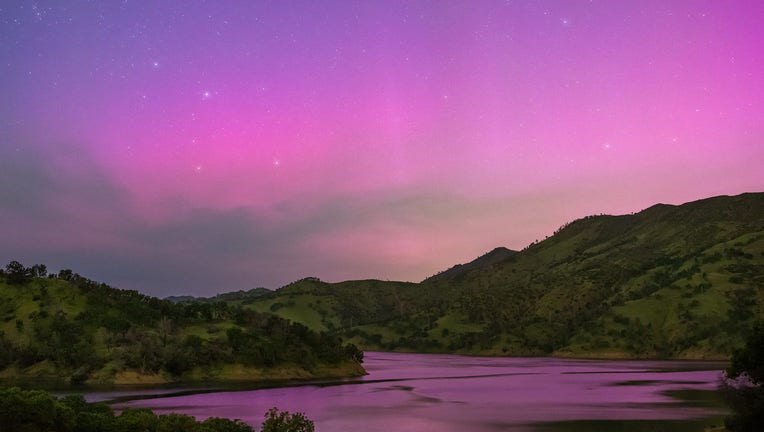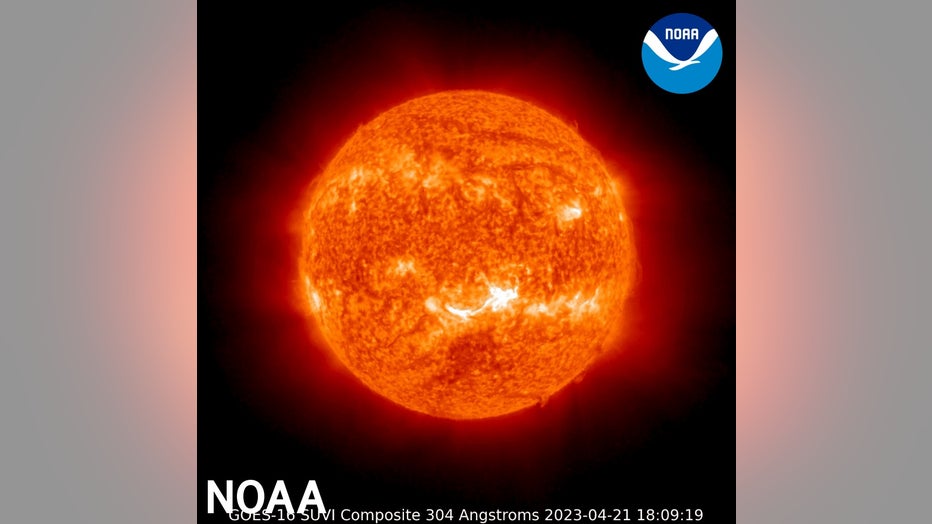Photographer captures rare, spectacular Northern Lights show in Bay Area

Bay Area photographer Mike Kruze captured a rare Northern Lights display at Lake Berryessa in Napa County on Sunday, April 23, 2023. (Mike Kruze / Twitter: @Mikeroburst / Instagram: @mike.kruze.photography / www.mikekruze.com)
NAPA, Calif. - A major geomagnetic storm last week led to rare and spectacular viewings of Northern Lights in California, and a Bay Area photographer was among the lucky sky-gazers who managed to capture the extraordinary event.
Photographer Mike Kruze posted a stunning image taken from Lake Berryessa’s southeast side, off Highway 128 in Napa County on Sunday.
Kruze, a San Jose software engineer, who makes it a hobby to capture nature, landscape and weather photos, said he saw a lot of chatter on social media earlier in the day about Northern Light sightings from Europe and the East Coast, and he knew he might have a chance to view one himself.
So he took his camera and headed north, looking for the perfect spot dark enough for the best viewing. And he said that at the same time he sought out a location that offered a setting representative of Northern California, knowing what a rare event it was for the region.
"I wonder if Lake Berryessa is a good place with a clear view to the north that might catch a reflection in the lake?" he said he considered.
And that’s where he landed. "Last night was the first time I've ever seen the northern lights in California!" Kruze posted on Twitter on Monday along with a photo of the aurora display.
He shared his experience with KTVU, as the photographer noted that his timing couldn’t have been better.
"Here is the incredibly lucky part," Kruze said. "I got there at about 9 o'clock, set up my gear, took a couple pictures and okay, nothing special."
But then after 10 minutes, a celestial transformation occurred.
"The whole sky started to turn colors," he said, allowing him to get that magical shot.
Kruze noted that his photo also captured a dark cloud on the horizon and that within 15 minutes that cloud moved in and took over the whole space. So his timing was everything.
SEE ALSO: Starship explodes: Giant SpaceX rocket fails minutes after launching from Texas
The photographer said he was able to get the shot using specialized equipment and described how difficult it would have been to catch the moment with the naked eye.
"To see it with a naked eye, you would have to look at it somewhere dark. You could see the extra light in the sky, but the camera picks up the red that you can see to get a picture like that. It definitely helps with an SLR [single-lens reflex] camera or mirrorless camera," Kruze explained.
His photo, imbued with an ephemeral purple hue showed the sky reflected onto the lake. Since posting the image on social media, it's been shared hundreds of times, with many remarking on what an incredible sight it was for this region.
Kruze said that many have expressed how surprising and what a treat it was to see a photo of the event taking place in California.
"Northern lights spilled out of the Arctic Circle all the way down to the US-Mexico border," according to the website Spaceweather.com
The aurora was triggered by a severe geomagnetic storm that was generated by a coronal mass ejection (CME), also known as an eruption in the sun on Friday, officials with the National Oceanic and Atmospheric Administration (NOAA) said.

Photo showing severe geomagnetic storm on Earth April 23, 2023. The storm was caused by a sun eruption associated with a solar flare. (Credit: NOAA)
"Ejected plasma from the eruption traveled at nearly two million miles per hour toward Earth," the agency explained, noting that it measured a level four out of five on its geomagnetic storm scale.
The result of the severe celestial storm was a breathtaking light show for lucky spectators and photographers like Kruze.
The longtime photographer said he’s taken a vast number of weather and nature photos over the years, and being in Northern California has allowed him to capture some of the most striking and scenic sights.
"While not exactly a hotbed of severe weather, living in California has given me access to some of the most beautiful scenery in North America," he shared on his website.
But the aurora he shot on Sunday, he said, was certainly among the most special and unique.
Bay Area sky-gazers now hoping to get an aurora moment of their own from last week's solar event, were out of luck.
"It has been an evolving situation, but the aurora show is now over," NOAA spokesperson Maureen O'Leary told KTVU.
While it’s unclear if California might get another impressive display like this recent one, scientists said geomagnetic activity from the sun, which can trigger the Northern Lights, has increased and will continue to do so.
"Energetic events like solar flares and coronal mass ejections have become more frequent in the past year, and especially in the past month," NOAA said, "and we expect activity to continue ramping up to the peak next year."
Increased activity leads to more opportunities to see the aurora, and scientists advised those who were hoping to capture the next Northern Lights show to situate themselves in areas without light pollution or cloud cover.

